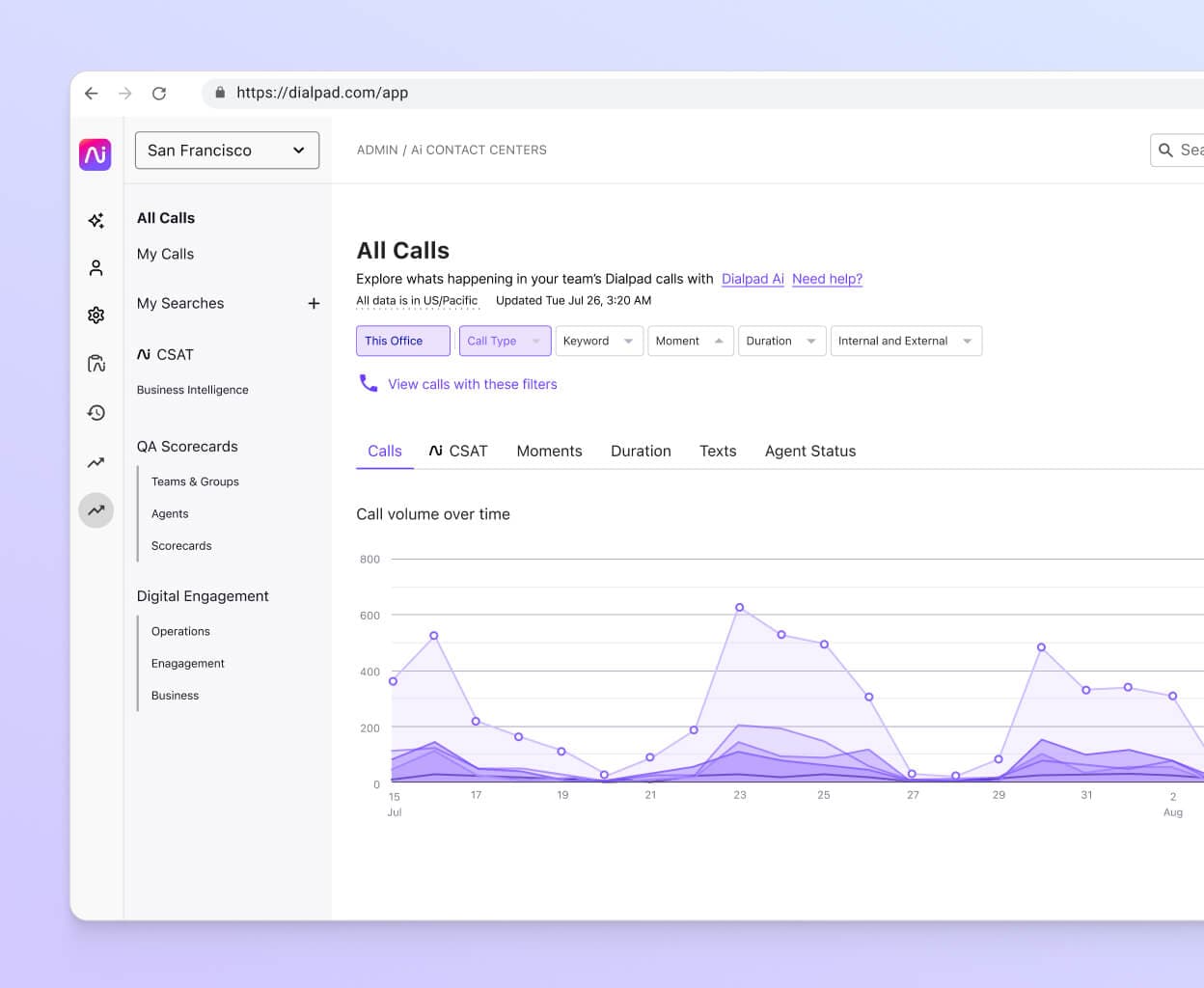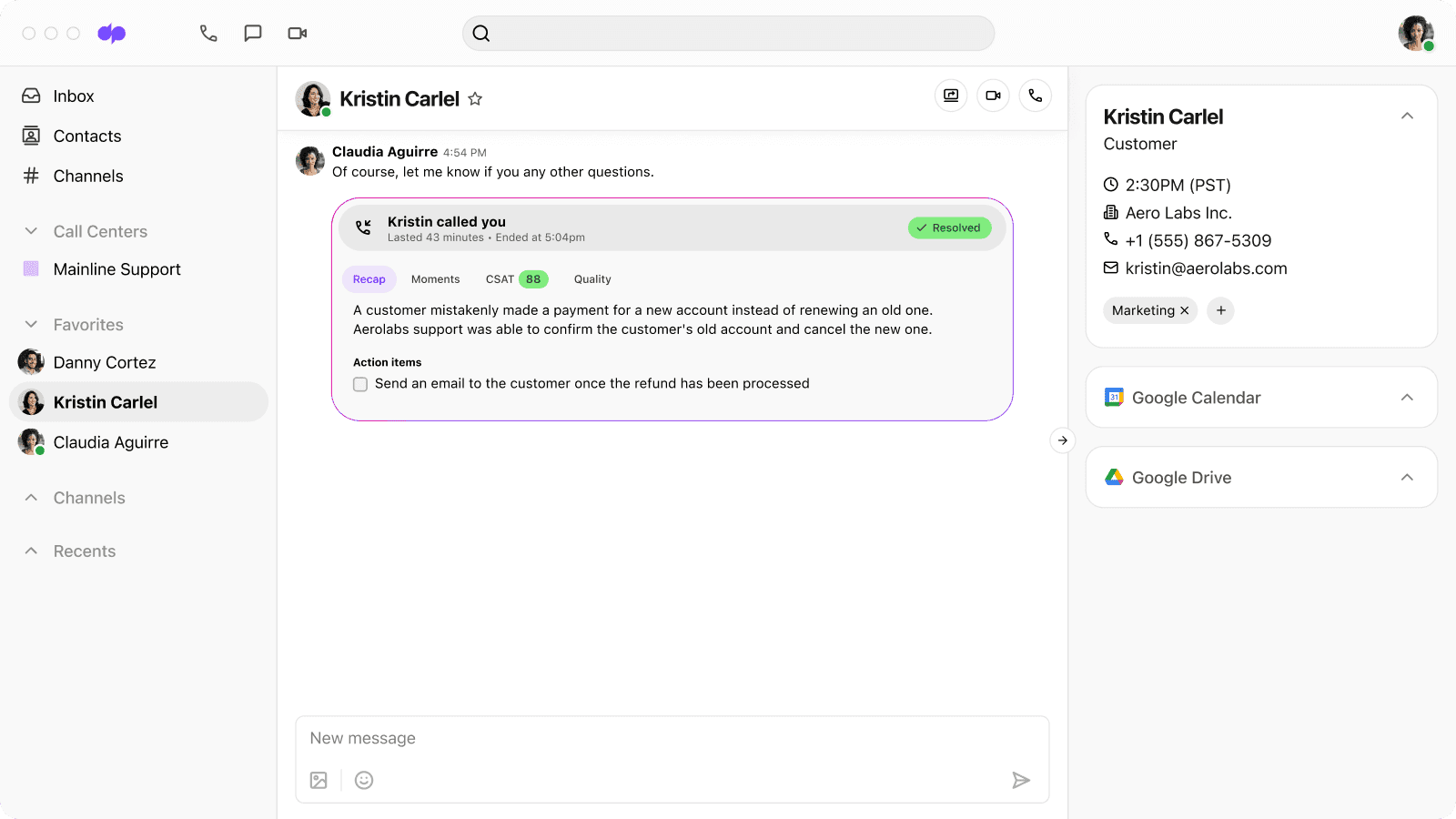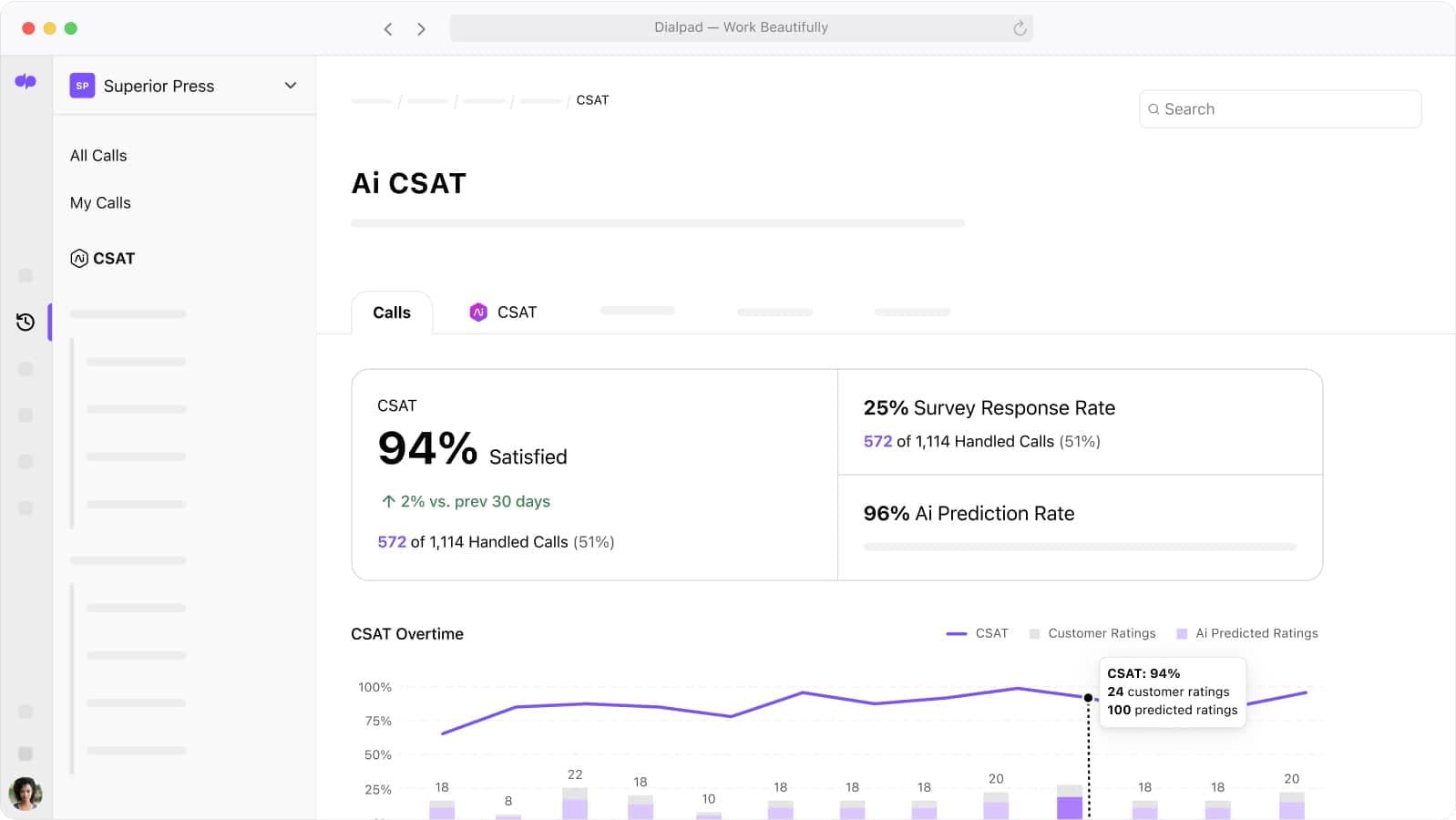
Tags
Share
Exceptional customer service is crucial for maintaining a competitive edge. For call centers, delivering high-quality customer interactions can be challenging but immensely rewarding.
This blog post will share 20 expert tips for improving call center customer service, offering actionable insights to elevate your team’s performance and enhance customer satisfaction. Whether you’re a seasoned manager or new to the field, these tips will help you drive meaningful improvements in your call center operations.
20 Expert tips for improving call center customer service
Now, let’s look at 20 call center tips for customer satisfaction—for both managers and agents.
We use many of these in our own customer service contact center here, and with so many remote agents, I’ve found these strategies helpful —especially since we’re a pretty high-volume contact center. (We provide 24/7 support over phone and live chat.)
If you’re looking for call center improvement ideas to empower your agents, keep customers happy, and also improve overall performance, keep reading.
1. Invest in agent training
You can’t get around it—a comprehensive, thoughtfully designed training program is the foundation of excellent customer service.
Make sure all new agents receive thorough training on your products, services, and preferred customer handling techniques.
The specifics of your training program can vary—some teams incorporate role-playing exercises and real-life scenarios to build confidence and competence, while others focus more on making agents practice what they’ve learned in real-world scenarios.
The most important thing here is to not just do training as a one-off project—your training materials and program should be regularly updated as your products and industry evolve.
2. Empower agents with knowledge bases
Giving agents access to a comprehensive knowledge base is one of the most effective ways to improve customer service in your contact center.
A well-organized, up-to-date knowledge base equips agents with the information they need to quickly address any and all customer questions, troubleshoot problems, and provide accurate solutions.
This means agents can resolve issues more efficiently, which reduces hold times and increases customer satisfaction. There are tons of options out there—some companies have just an internal wiki or webpage that has a list of FAQs, while others have more sophisticated digital hubs that also have slide decks, short videos, and other multimedia information for agents.
The biggest challenge with these, though, is that agents often have to manually search through the entire database to find the answer to a specific question, which can be time-consuming, especially if your repository isn’t organized well.
AI has helped our team to combat this. Because Diapad Ai Contact Center can integrate with all our knowledge sources, it can instantly pull information from all of our training PDFs, decks, and even unstructured data sources like call recordings.
Dialpad Ai understands natural language queries, which means it can “talk to” our agents and provide accurate, relevant results in real time, ensuring that they can quickly get the information they need:

3. Use call whisper for real-time coaching
Have a lot of inexperienced agents? Call whisper is a great tool that lets supervisors coach agents in real time during live calls.
Supervisors can discreetly communicate with agents, offering feedback and suggestions without the customer hearing anything. For instance, if an agent is handling a complex customer issue or struggling with a sales pitch, the supervisor can use call whisper to provide strategic advice, suggest alternative approaches, or remind the agent of key talking points.
This hands-on approach helps accelerate the learning process, giving agents an opportunity to quickly refine their skills and improve their performance while still maintaining a smooth and professional customer experience.
4. Optimize call routing for faster resolutions
One simple way contact centers can get customers to the right department or get the answers they’re looking for more quickly is by optimizing call routing.
It doesn’t have to be fancy, but even a well-designed IVR (interactive voice response) menu can automate the routing process and direct calls to the most suitable agents based on their skills or expertise.
For example, calls related to technical support can be routed directly to agents with specialized technical skills, while billing inquiries can be directed to the billing team. This targeted routing reduces the chances of call transfers and escalations, leading to quicker resolutions—and the best thing is, customers won’t have to keep repeating themselves because they won’t need to be transferred back and forth between agents.
5. Set clear, achievable goals for agents
To improve your customer service, you have to be able to measure it. So, define those metrics—some call center KPI examples: average handle time, first-call resolution rates, and customer satisfaction scores.
Even though many of these are important for all contact centers, the specific set of metrics that your team measures may not be the same as those for a contact center in another industry or of a different size.
When you’re setting goals, make sure they’re specific and ambitious, but realistic. For example, setting a goal for reducing average handle time by a certain percentage or increasing the first-call resolution rate can provide agents with clear benchmarks to work towards.
Your contact center platform should have some analytics features that can help with this. Dialpad Ai Contact Center, for example, has a clean dashboard that helps you track foundational metrics and KPIs like call volumes, wait times, and average handle time:

6. Encourage active listening on all calls
Active listening is a soft skill and customer service etiquette aside, it’s crucial to agents being able to provide a good customer experience.
To encourage active listening, integrate focused training and reinforcement strategies into your training and processes. Onboarding programs should emphasize the importance of active listening techniques, like paraphrasing customer statements, asking clarifying questions, and summarizing key points of the conversation.
Implementing real-time transcription and AI summaries can also really enhance agents' ability to stay focused during calls. We use Dialpad Ai’s live transcriptions and AI Recap to help agents stay focused, since they don’t have to take notes manually:

7. Personalize customer interactions
To personalize customer interactions, your agents need to have customer data. Help them access and leverage this customer data by integrating your CRM system to your contact center platform.
This will help agents quickly pull up customers’ information and use it to tailor their conversations based on individual preferences and past interactions or purchases during the call.
For example, if an agent knows a customer has recently purchased a product or expressed interest in specific services, they can reference these details to make the conversation more relevant to the customer.
Dialpad Ai Contact Center, for example, integrates with popular CRMs like Salesforce, HubSpot, Copper, and more. Not only does it embed its dialer right into those CRM interfaces (which means less toggling back and forth between different windows), it also pulls Dialpad’s Ai-powered coaching features directly into those tools.
8. Leverage self-service options to reduce call volume
A good way to keep customers happy is to reduce call volumes and help them solve their problems more quickly, preferably with user-friendly tools.
Options such as interactive voice response (IVR) systems, online FAQs, and self-service portals all empower customers to find answers to common questions, complete transactions, or perform routine tasks without needing to speak with an agent.
For instance, an AI chatbot that helps customers track orders, update personal information, or manage their accounts can significantly reduce the number of calls related to these routine inquiries. By offering these self-service solutions, you can not only alleviate the pressure on your agents, but also increase productivity and shorten all wait-time-related metrics.
Advanced self-service technologies like conversational AI and virtual assistants are especially helpful for high volume contact centers—an AI chatbot can handle multiple customer queries at once, at all hours of the day or night.
You can drag and drop different conversational flows together with just a few clicks—no coding or developer support needed.
9. Monitor and provide real-time feedback
Call monitoring tools are super helpful (and a core weapon in your contact center management arsenal) because they give coaches live insights into agent interactions. These tools let us listen in on calls, monitor performance, and observe agent behavior in real time.
By analyzing live calls, supervisors can also identify areas where agents may need immediate help or guidance (like when they’re handling challenging customer inquiries or need to adhere to regulatory requirements).
Monitoring is also helpful for post-call reviews. Supervisors can provide constructive feedback based on live observations they collected during the call, and give agents specific examples to help them understand their performance and areas for improvement.
Regularly scheduled feedback sessions and performance reviews, coupled with these real-time interventions, are a great way to help agents continuously improve their skills and deliver exceptional customer service (and contributes to the overall effectiveness and efficiency of the contact center too).
10. Simplify and improve call scripts
Don’t overwhelm your agents with scripts. Focus on clarity and conciseness to ensure agents can communicate effectively without confusing customers.
Structure your scripts with clear, logical flows. Avoid jargon, use straightforward language, and incorporate bullet points or decision trees to make them more skimmable for agents.
For instance, rather than a lengthy script with lots of paragraphs, a simplified version might use short, actionable phrases and clearly defined steps for agents to follow. This approach helps agents stay on track and respond to customer needs efficiently, enhancing the overall customer experience.
11. Reward and recognize outstanding agent performance
Your agents are the heart of your customer experience. To keep them happy, establish a structured recognition program that highlights achievements and encourages ongoing excellence.
This program might include different forms of recognition, such as monthly awards, acknowledgments during town halls, or performance-based bonuses. For example, top-performing agents could be celebrated in team meetings, featured in internal newsletters, or awarded gift cards or extra time off. By celebrating individual and team successes, you can foster a positive work environment and motivate agents to keep striving for an excellent customer experience.
12. Create a positive work environment
On a related note, a positive work environment can go a long way in helping agents feel comfortable sharing their ideas, concerns, and feedback.
Regular team meetings and anonymous surveys are good for gathering input, and by addressing issues proactively, you can improve engagement, boost morale, and retain more agents (which lowers onboarding and hiring costs).
13. Use post-call surveys for customer feedback
If you’re not sure what to do to improve your customer service, customer satisfaction surveys are a solid go-to.
Always send out surveys right after the interaction while the memory is fresh in your customers’ minds—this feedback will help you pinpoint specific issues, track trends over time, and make data-driven decisions to enhance service quality.
Of course, one of the biggest challenges with these surveys is that many customers don’t bother filling them out. And the ones that do are usually the most angry or frustrated customers—which skews your results unfairly.
We noticed this happening a lot, so we designed Dialpad’s Ai CSAT feature to overcome this obstacle. It can automatically analyze customer conversations—up to 100% of customer calls—and infer a CSAT score with a high degree of accuracy:

This gives us a much more representative sample size for CSAT scores, and a more accurate understanding of how satisfied customers really are.
14. Reduce call wait times with callback options
Another way to improve customer service is by offering callback options, which lets callers opt for a return call instead of waiting on hold.
This not only improves the customer experience by minimizing their time spent waiting, but also helps you manage call volumes more effectively.
15. Foster collaboration among teams
Regular interdepartmental meetings and collaborative projects can help break down silos and encourage the exchange of insights and best practices, which helps every team whether that’s directly or indirectly. It also improves cross team collaboration, allowing different departments to work more efficiently toward shared goals.
For example, integrating customer service teams with product development or marketing departments can ensure that agents are well-informed about new products or updates, leading to more accurate and effective customer interactions.
16. Use customer interaction analytics
This step is important for understanding customer behavior, preferences, and pain points across different channels like phone calls, chat, and social media.
For example, if you’re getting more frequent complaints and the analytics back it up by revealing long wait times or repeated issues with a particular service, you can address these concerns by optimizing staffing levels or refining service procedures.
Some interaction analytics tools also show things like customer sentiment—Dialpad Ai Contact Center flags calls with negative sentiment so that we can quickly see which agents might need help, scan the transcript to get more context, and then jump in if needed.
17. Maintain consistent quality with regular QA reviews
Regular QA reviews are super important because they help you build a structured and systematic approach to evaluating agent performance and service interactions.
This might involve analyzing recorded calls or interactions to assess adherence to established service standards, identify areas for improvement, and ensure compliance with industry regulations (if you work in healthcare or finance).
A feature that we find useful is Dialpad's Ai Scorecards, which helps our supervisors not have to listen to every single call.
With Ai Scorecards, we can create an objective scoring criteria across all customer calls. As the agent behavior is observed by Dialpad Ai, it's automatically checked off—so when the supervisor reviews the call later, they can easily see the agent is doing the tasks they're supposed to during customer interactions.
18. Keep agents informed about product or service updates
There are a few ways to do this. You could implement a robust communication strategy that includes regular briefings, updates, and accessible resources.
Or, you can work with other teams to schedule webinars where updates are discussed in detail, as well as real-time notifications through internal communication platforms or dashboards.
Don’t forget to update your knowledge base or intranet where agents are accessing information!
19. Empower agents to make decisions
The best way to empower your agents is to provide them with clear guidelines, autonomy, and access to relevant information—basically, many of the customer service tips for call centers we went through earlier.
By setting clear parameters within which agents can operate independently (can they offer discounts? How big of a discount can they give?), you’re empowering them to solve issues without needing constant supervisor approval.
And of course, don’t forget to equip agents with good training and up-to-date knowledge bases to make sure they have the confidence and content they need to make informed decisions.
20. Invest in the right call center technology
Carefully evaluate your specific needs and choose solutions based on those requirements.
This might involve selecting integrated systems that offer features such as advanced call routing, CRM integration, AI-driven analytics, and omnichannel support to streamline your processes and provide a more seamless customer experience.
If you have big growth plans, go for a scalable and adaptable solution that can evolve with your contact center’s growing demands (and customer expectations).
How to leverage data in your call center to enhance customer service
Leveraging data is crucial for measuring and improving customer service. Start by analyzing call metrics and customer feedback to identify any trends and areas for improvement.
At this point, you might use AI or more advanced analytics tools to gain deeper insights into customer behavior and preferences, which can help you tailor your service strategies.
Use this data to take action—optimize staffing levels, improve call routing, and enhance training programs. Regularly review performance reports and adjust your strategies based on data-driven insights to ensure continuous improvement and a better customer experience.
Key takeaways for providing exceptional call center customer service
To consistently deliver exceptional call center customer service, it's essential to consider both sides of the equation: agent performance and customer satisfaction.
These core principles will provide a foundation for creating a supportive environment for your team and a positive experience for your customers. Here are some of the top takeaways to keep in mind as you’re building or refining your customer service strategy:
1. Prioritize comprehensive training
Equip agents with the knowledge and skills needed to handle diverse customer interactions effectively. A comprehensive training program should cover product knowledge, communication techniques, and problem-solving skills to make sure your agents are prepared for any situation.
2. Use technology strategically
Invest in the right tools and technologies to streamline operations and enhance service quality, like CRM software and conversational intelligence tools. One thing to consider is that your tech stack should integrate with each other (and your existing processes).
3. Foster a customer-centric culture
Build a culture where exceptional customer service is a core value and all agents are empowered to deliver it. Encourage a mindset that prioritizes the customer's needs and satisfaction at every touchpoint, and provide agents with the autonomy and resources they need to make decisions that benefit the customer.
4. Leverage data for continuous improvement
Use data insights to drive decisions and refine processes, ensuring your call center evolves with customer needs. Regularly analyze key performance metrics, customer feedback, and call trends to identify areas for improvement and implement targeted strategies.
5. Promote agent well-being
Support your agents' well-being and job satisfaction to maintain a motivated and high-performing team. Offer flexible scheduling, opportunities for professional development, and a positive work environment to help agents manage stress and maintain a healthy work-life balance.
Improve call center customer service with Dialpad
Whether you’re just starting out or not, improving your customer service call center is a continuous journey that involves a combination of strategy, technology, and a dedicated approach to agent development.
From investing in comprehensive training and leveraging data and AI tools, each step contributes to delivering exceptional service that meets and exceeds customer expectations.
Running a customer experience call center?
See how Dialpad Ai Contact Center can help you improve your CX. Book a product tour with our team to get a hands-on look at the features we mentioned in this blog, like Ai Recaps, Ai Scorecards, and more!









